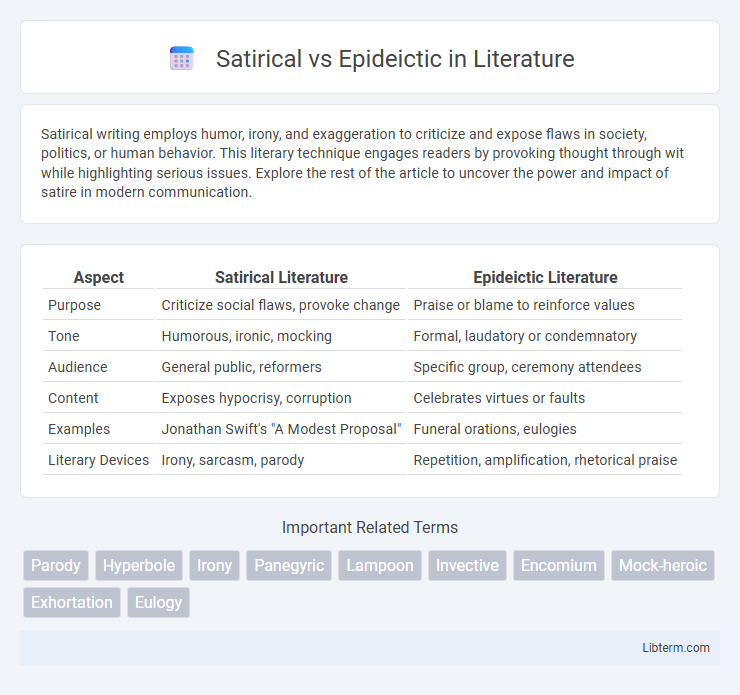Satirical writing employs humor, irony, and exaggeration to criticize and expose flaws in society, politics, or human behavior. This literary technique engages readers by provoking thought through wit while highlighting serious issues. Explore the rest of the article to uncover the power and impact of satire in modern communication.
Table of Comparison
| Aspect | Satirical Literature | Epideictic Literature |
|---|---|---|
| Purpose | Criticize social flaws, provoke change | Praise or blame to reinforce values |
| Tone | Humorous, ironic, mocking | Formal, laudatory or condemnatory |
| Audience | General public, reformers | Specific group, ceremony attendees |
| Content | Exposes hypocrisy, corruption | Celebrates virtues or faults |
| Examples | Jonathan Swift's "A Modest Proposal" | Funeral orations, eulogies |
| Literary Devices | Irony, sarcasm, parody | Repetition, amplification, rhetorical praise |
Understanding Satirical Rhetoric
Satirical rhetoric employs humor, irony, and exaggeration to expose and criticize societal flaws, often targeting individuals, institutions, or behaviors with the intent to provoke change or reflection. Unlike epideictic rhetoric, which primarily praises or blames to uphold communal values during ceremonial occasions, satire challenges norms through subversive and confrontational techniques. Mastering satirical rhetoric involves recognizing its use of wit and paradox to engage audiences emotionally and intellectually, making complex social critiques more accessible and impactful.
What Defines Epideictic Discourse?
Epideictic discourse is defined by its rhetorical purpose of praise or blame, primarily aimed at celebrating or condemning a person, event, or idea to reinforce shared values within a community. It often appears in ceremonial contexts such as funerals, celebrations, or commemorations, emphasizing virtues, ethical qualities, and societal norms. The style is characterized by emotive language and vivid imagery designed to evoke admiration or contempt, distinguishing it from the critical and ironic tone typical of satirical discourse.
Core Purposes: Satirical vs Epideictic
Satirical rhetoric targets exposing flaws and critiquing societal norms through humor and irony, aiming to provoke reflection or change. Epideictic rhetoric, often used in ceremonial contexts, emphasizes praise or blame to reinforce shared values and community cohesion. Both serve distinct communicative goals: satire challenges and questions, while epideictic celebrates and affirms.
Techniques and Strategies in Satire
Satirical techniques often employ irony, parody, and exaggeration to expose flaws or criticize societal issues, using humor as a tool for engagement and reflection. Strategies such as sarcasm, juxtaposition, and absurdity highlight contradictions and provoke critical thinking, encouraging audiences to question accepted norms. Unlike epideictic rhetoric that praises or blames to reinforce values, satire strategically undermines through subversion and wit to challenge conventional perspectives.
Tools of Praise and Blame in Epideictic Rhetoric
Epideictic rhetoric employs tools of praise and blame to reinforce communal values and celebrate or condemn specific behaviors, often through vivid descriptions, analogies, and emotional appeals. It utilizes encomium for praise, highlighting virtues and exemplary traits, while invective serves as a tool for blame, condemning vices and faults with sharp criticism. These techniques strengthen social cohesion by affirming shared ideals and moral standards within the audience.
Audience Engagement: Satirical vs Epideictic Appeals
Satirical appeals engage audiences by using humor, irony, and exaggeration to provoke critical reflection and challenge societal norms, effectively capturing attention through entertainment and subversion. Epideictic appeals focus on praise or blame to reinforce shared values and foster communal identity, often evoking emotional resonance and collective agreement. Both modes strategically tailor their rhetorical techniques to influence audience perception, but satire relies on critical distance while epideictic seeks affirmation of communal ideals.
Historical Examples of Satirical Rhetoric
Satirical rhetoric employs humor, irony, and exaggeration to criticize society or individuals, with historical examples such as Jonathan Swift's "A Modest Proposal" exposing social injustices through biting satire. In contrast, epideictic rhetoric is used to praise or blame during ceremonial speeches, focusing more on values and virtues than critique. Swift's satirical essay highlights the power of satire to provoke critical reflection and social change during the Enlightenment era.
Notable Instances of Epideictic Oratory
Epideictic oratory, characterized by praise or blame, has notable instances such as Pericles' Funeral Oration that eulogize civic virtues and valor, showcasing the power of public commendation in classical Athens. Cicero's "Panegyricus" exemplifies Roman epideictic oratory by extolling Emperor Augustus to reinforce political legitimacy and cultural values. These speeches emphasize ethos and pathos to celebrate communal identity and moral ideals, contrasting with satirical rhetoric that critiques through irony and humor.
Evaluating Effectiveness: Satirical vs Epideictic Outcomes
Satirical rhetoric uses humor, irony, and exaggeration to critique and provoke change, often resulting in heightened awareness or social reflection by exposing flaws in individuals or institutions. Epideictic rhetoric, centered on praise or blame, reinforces shared values and strengthens community identity, fostering cohesion and moral alignment among audiences. Evaluating effectiveness depends on goals: satire excels at challenging norms and sparking critical thought, while epideictic discourse solidifies consensus and emotional resonance within a group.
Modern Applications in Media and Communication
Satirical communication in modern media employs irony, humor, and exaggeration to critique social and political issues, often published through digital platforms like social media, webcomics, and satirical news websites such as The Onion. Epideictic rhetoric today is prevalent in ceremonial speeches, influencer endorsements, and brand storytelling, emphasizing praise or blame to reinforce community values and identity in formats like keynote presentations and viral marketing campaigns. Both forms drive audience engagement by strategically shaping perceptions--satire challenges status quos while epideictic affirms collective ideals in contemporary communication landscapes.
Satirical Infographic

 libterm.com
libterm.com